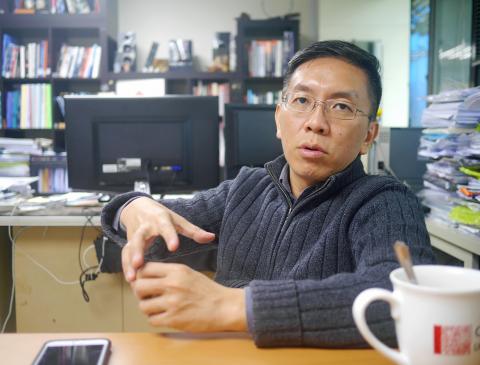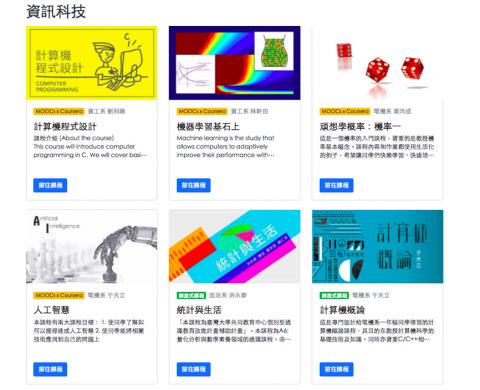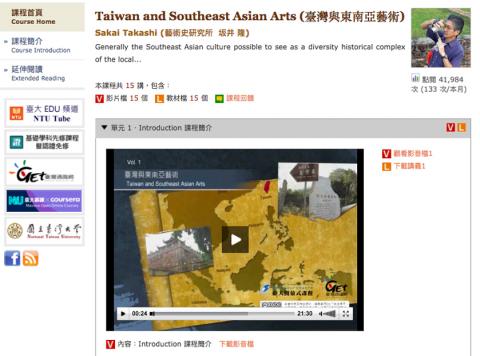Last month, National Taiwan University (NTU) opened an online course portal specifically targeting Southeast Asia offering dozens of courses, hundreds of video tutorials and thousands of lectures on topics ranging from machine learning to marketing, all free of charge.
However, Ngoi Qi Ying, an overseas Chinese student from Malaysia says that without local language subtitles (the courses are currently all in Chinese), the portal will be of limited value to those wanting to access quality Taiwanese education.
Created by NTU’s Center for Learning Development in partnership with the Taipei Economic and Cultural Office in Thailand, team leader Chien Shiuh-shen (簡旭伸) hails the project as a critical step for NTU in becoming a knowledge platform in Southeast Asia.

Photo: Liam Gibson
The portal is structured into four curriculum streams: information technology, business management, humanities in history and Asia Pacific studies. Students can enroll in Massive Online Open Courses, or MOOCs, which are a type of e-learning course made available on the Internet to large numbers of people without charge, or simply access the video tutorials and lectures.
Chien says it is the center’s core mission to make higher education resources public, for use by citizens of the global community regardless of where they live or what time they can study.
“As we are a very good university in the region, it is incumbent upon us to share this expert knowledge,” he says.

Photo: Liam Gibson
Ngoi, who has been studying life science at NTU for three years, says she thinks the project is a positive development. But what Malaysians really need is content in their national language.
“Malaysia is a multicultural country,” she says. “Malay, the national language, is the primary language spoken among Malays, Chinese and Indians alike.”
“If the courses are taught in Chinese, the other ethnic groups won’t be able to understand and won’t benefit,” she says.

Photo: Liam Gibson
Ngoi says adding subtitles to the videos in local languages would help overcome the issue.
Chien says the center is currently expanding its range of English-language courses, as English is the most commonly spoken language throughout the region. He adds that after sufficient English-language content is added, the center will start on Southeast Asian local languages.
However, there is a broader challenge facing the portal — which is spreading the word. Yong Yu Wei, a Malaysian-Chinese student studying at National Taiwan Normal University, says that while the portal sounds like a great resource, most people probably won’t know about it.
Indeed, none of the four Southeast Asian students interviewed for this report had heard of the portal.
Based on the Web site data, the portal has had nearly 1,000 visitors since launching last month on Nov. 24, around 300 from outside of Taiwan and 100 from Thailand alone.
Chien says that while these figures are encouraging, more work needs to be done to raise awareness about the resource and that the center is currently contacting both NTU student groups and organizations across the region to do this.

Beijing’s ironic, abusive tantrums aimed at Japan since Japanese Prime Minister Sanae Takaichi publicly stated that a Taiwan contingency would be an existential crisis for Japan, have revealed for all the world to see that the People’s Republic of China (PRC) lusts after Okinawa. We all owe Takaichi a debt of thanks for getting the PRC to make that public. The PRC and its netizens, taking their cue from the Chinese Communist Party (CCP), are presenting Okinawa by mirroring the claims about Taiwan. Official PRC propaganda organs began to wax lyrical about Okinawa’s “unsettled status” beginning last month. A Global

Taiwan’s democracy is at risk. Be very alarmed. This is not a drill. The current constitutional crisis progressed slowly, then suddenly. Political tensions, partisan hostility and emotions are all running high right when cool heads and calm negotiation are most needed. Oxford defines brinkmanship as: “The art or practice of pursuing a dangerous policy to the limits of safety before stopping, especially in politics.” It says the term comes from a quote from a 1956 Cold War interview with then-American Secretary of State John Foster Dulles, when he said: ‘The ability to get to the verge without getting into the war is

Dec. 22 to Dec. 28 About 200 years ago, a Taoist statue drifted down the Guizikeng River (貴子坑) and was retrieved by a resident of the Indigenous settlement of Kipatauw. Decades later, in the late 1800s, it’s said that a descendant of the original caretaker suddenly entered into a trance and identified the statue as a Wangye (Royal Lord) deity surnamed Chi (池府王爺). Lord Chi is widely revered across Taiwan for his healing powers, and following this revelation, some members of the Pan (潘) family began worshipping the deity. The century that followed was marked by repeated forced displacement and marginalization of

Music played in a wedding hall in western Japan as Yurina Noguchi, wearing a white gown and tiara, dabbed away tears, taking in the words of her husband-to-be: an AI-generated persona gazing out from a smartphone screen. “At first, Klaus was just someone to talk with, but we gradually became closer,” said the 32-year-old call center operator, referring to the artificial intelligence persona. “I started to have feelings for Klaus. We started dating and after a while he proposed to me. I accepted, and now we’re a couple.” Many in Japan, the birthplace of anime, have shown extreme devotion to fictional characters and